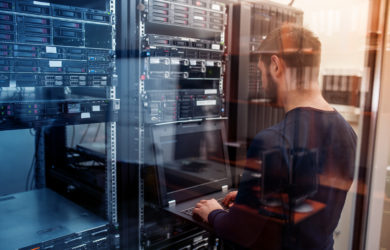How storefronts keep pace with webshops
Brick-and-mortar retail is showing increasing interest in indoor navigation and the challenges and opportunities it presents. For the customer, it means a more positive shopping experience, while for the operator it represents a unique selling proposition and gives them the opportunity to collect valuable data on shopper behavior.
An indoor positioning system (IPS) is a network of devices that can locate people or things in rooms without GPS reception. Via an IPS connection, navigation devices can also be used in enclosed spaces such as exhibition halls, shopping malls, department stores or supermarkets.
The opportunities that indoor navigation opens up for stationary retail extend far beyond finding an item on the shelf. The cell phone as a helper when working through the shopping list marks only the first stage of a digital retrofit of the sales floor.
Concept and method
IPSs make use of (tri-) lateration: If the position of two points in space is known, the location of a third point can be calculated from this according to the rules of triangular geometry, for example the constantly changing location of a mobile device in a building. Commercial IPSs track this mobile point either with fixed tracking devices (Bluetooth, WLAN, RFID, broadband), referred to here as beacons, or with the aid of optical solutions.
Visible Light Communication (VLC) is one of the optical methods. Instead of using radio beacons, it locates the mobile device via fluorescent lamps or light-emitting diodes (LEDs) in the interior lighting. The location of a light is reported by an individual code contained in the light beam, which is not perceived by the human eye. Other options for optical location determination include scanning QR codes with location information or optical trilateration of prominent navigation points via the camera.
The most common is lateration with low-power Bluetooth beacons (Bluetooth Low Energy, BLE). As with GPS (Global Positioning System), the distance is measured by the propagation time of the tracking signal from the transmitter to the receiver. If enough beacons are distributed in a store, they can be used to track the customer’s path through the product range. Depending on the customer’s behavior or current location, he or she can, for example, be offered a discount via a push message, other interesting items can be suggested, or further advice can be provided.
The hardware of modern smartphones is perfectly sufficient to support different types of IPS. Both Bluetooth lateration and various optical navigation methods can be used. All that is needed is to provide the appropriate software in the form of a user-friendly app.
Business value
By recording and evaluating the customer’s navigation through the store, stationary retailers are methodically catching up with online retailers. Since the mid-1990s, operators of commercial websites in particular have been using tracking and analysis tools such as Google Analytics, with which they collect a wide range of key performance indicators (KPIs) on user behavior and evaluate them to optimize interaction. Such tools have been lacking in brick-and-mortar retail until now. The interests and preferences of customers could only be determined at great expense and on a narrow data basis, for example by panel study or observation of individual customers in the store. However, many of the key data collected on the web can be transferred to stationary retail with the appropriate hardware and software.










